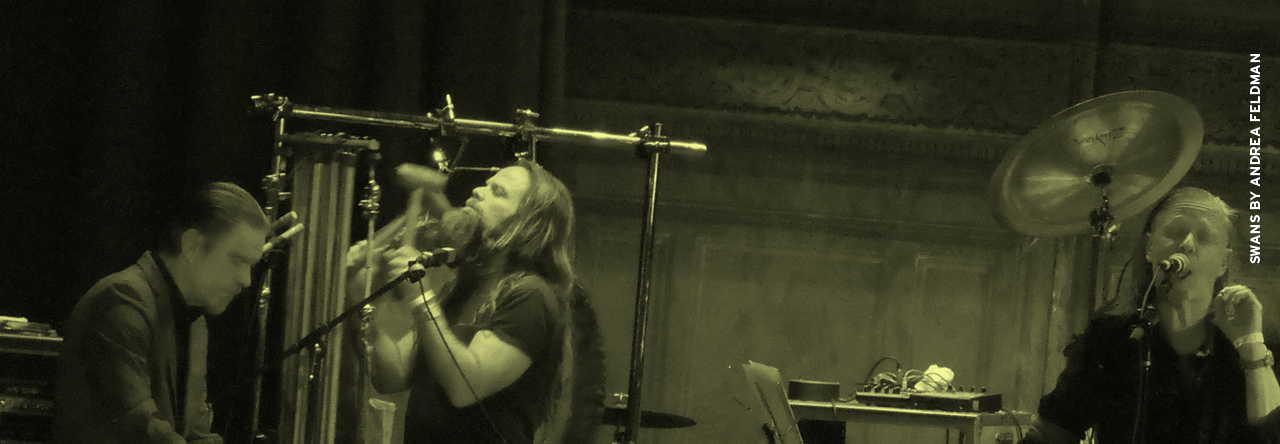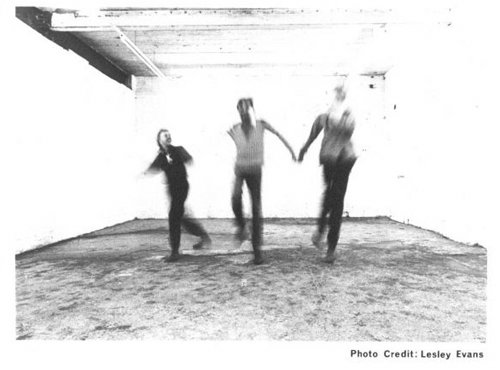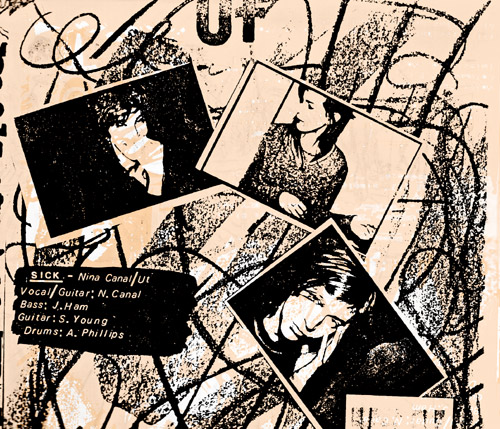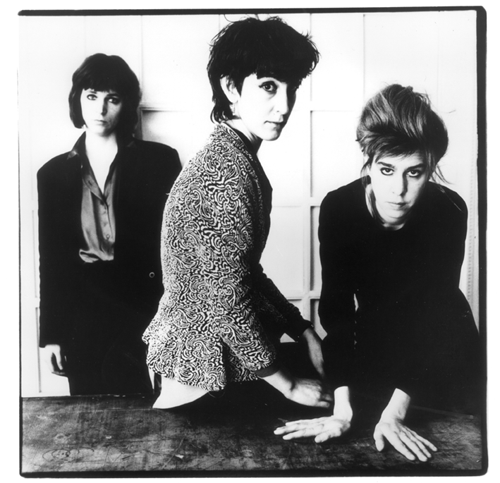

UT gained notoriety for its markedly democratic approach to making music, having no lead singer per se and making a point of switching off on instruments. Was this non-hierarchical approach difficult to maintain? (We’re so used to fixed focal points in bands, even ones with avant-gardist tendencies, that any other arrangement automatically seems potentially fraught.)
Jacqui: We came to it because we were all musical that way. We wanted to subvert the hierarchical thing but we were mainly into the heightened perspective you get playing from every vantage point. We were into how it expanded the sound and the character of the songs —it was thrilling for us to have all these different combinations beside the fact that we were conceptually into shaking things up. But we were not strict about it.
We had different sounds and complexions on the instruments and exploring the merge and combustion was inspiring to us. We were always discovering and attempting new things —we had the sense that all was possible. We had this way of spontaneously composing and the main thing for us was to serve the music and to take everything further.
Nina: Our “democratic” thing sprung entirely from who we were as people and our natal politics as it were, and so for us it always made sense —even if at times it caused problems, like every system in fact.
We decided to change instruments as well as all other “jobs” in the band —we had a kind-of saying that we each got to be both the “controller and the dustbin collector” at different times!
We were often accused of being aggressive in both our music and our approach so I’m not sure at that time it was ever seen in any way as a “quiet radical” thing!
Sally: Our decision to switch instruments didn’t come about as a dogmatic idea or conceptual plan. It was just more fun and stimulating that way, as we all enjoyed the experience of playing different instruments and exploring what we could do on them. We didn’t think our identity was limited to playing just one particular instrument (that is, none of us felt we were just a guitar player or just a singer or just a drummer, etc.) and it kept us in the mode of constantly experimenting without getting into ruts with any one instrument. Swapping instruments probably did have the innate effect of negating any potentially hierarchical developments within the band, as well as keeping audiences and the media from pigeonholing us in specific roles. The only difficulty we had in maintaining this approach was a practical one, as during performances it took a certain amount of time to move from one instrument to another and to set oneself up in a different sphere.
We tried to take this into account when deciding on the order of the set, to avoid the awkward time gaps that switching instruments could lead to. But our consideration first and foremost was the dynamic and aesthetic order of the songs —we’d take in practical considerations only as long as they didn’t jar with this. For example, if there were two or three songs in the set that Nina drummed on, we’d try to put these next to each other, unless the songs really didn’t complement each other aesthetically/dynamically in such close juxtaposition.
We always put a great deal of thought into the order of our sets for gigs and our tracks on albums to attain the strongest dynamic movement and progression, like arranging scenes in a play. As for people being used to fixed focal points in bands, I’m sure that audiences may well have found us disconcerting. But then I don’t think disconcerting is such a bad thing to be. CONT’D>>
Have you attempted this arrangement in subsequent bands, or some variation thereof?
Jacqui: In [my current band] Dial I do the vocals but the composition is improvised together. It is the same process. Rob Smith and Dom Weeks are extraordinary musicians; we play mainly the same instruments but it is fluid.
What bands did you find the most kinship with (both in NYC and London)?
Sally: We felt a strong kinship with The Fall, as mentioned. Mark E Smith’s lyrics were something Jacqui and I in particular felt a great affinity with and his approach to singing and music made a lot of sense to us. As Jacqui and I lived in the same apartment in NYC, we would often end up listening to the same music. Jacqui listens to music a lot and picks up on things that are happening very quickly, and she had lived in NYC for a few years before I moved there, so she introduced me to lots of music. We also went out to gigs together all the time.
Mars and DNA were important bands for us. We also loved the “30 Seconds over Tokyo” era of Pere Ubu. We both related strongly to Patti Smith, Television and Richard Hell and the Voidoids, and it was really those three bands that led me into the downtown NY music scene at first.
PIL, too, were quite important, especially Keith Levine’s guitar playing. Soon after arriving in London, we saw The Birthday Party, who were a big inspiration, and we enjoyed playing some gigs with them. And yeah, we felt in good company with other Blast First bands like Sonic Youth and we got on well with The Butthole Surfers, who had a great approach to both music and humour.
Jacqui: Bands in our area around the time of Ut: Mars DNA Red Transistor Pere Ubu The Fall PiL Joy Division Television Richard Hell Voidoids Iggy Pop This Heat Birthday Party and later Neubauten, the Virgin Prunes, Sonic Youth, Bad Seeds, Swans, Big Black, My Bloody Valentine, the Dead C.
Nina: Yes, all those bands. I especially loved the Voidoids, Television, Pere Ubu, Mars, DNA, Swans, The Lounge lizards -—NYC was just saturated with great music. We were awash in it all the time, then in London we had The Birthday Party, Neubauten, PIL who were so important for their brief life, Joy Division. Of course Patti Smith for me was an enormous influence too, primarily in sense of her attitude and stance. I saw her play at the Roundhouse in London not long before going to NY and came away really inspired, ready for what happened to me when I got there —which was I got co-opted fast into The Gynaecologists because my best friend Robert Appleton (whom I knew from art school in London) had met Rhys and started a band together. They asked me to play guitar w them, which I duly did! I had never played music before except for a kind of Terry Riley-esque drumming workshop in London, I had studied mime briefly with Lindsay Kemp and was into performance art. In fact a large part of my work at art school was performance and film with my partner in crime Peri. In 1976 I chose between going to Germany to be where Joseph Beuys was teaching (except I didn’t speak German) or to NY to check it out —I went to NYC.
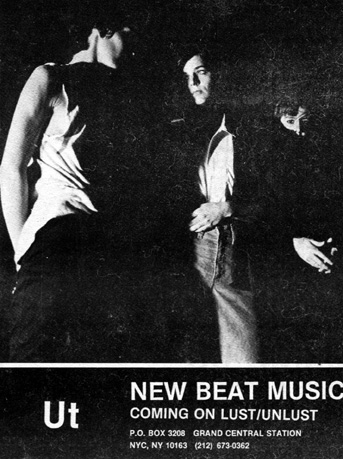
What factors led to the band’s dissolution?
Jacqui: After 11 years we wanted to do our own things. The musical bond is always present but we are onto different things now.
Sally: I think it just ran its course. We’d been through a lot together in 11 years. We’d toured in America and all over Europe (we’d even done a tour of Eastern Europe while it was still behind the iron curtain that was an incredible experience). But anyone who’s toured knows what hard work it is, especially how it puts people up close against each other in an uncomfortable way.
We’d also put out 3 studio albums, a live album and tape, and two studio EPs. The three of us were straining in different directions by the end. We had created a very fertile environment for growth, development and experimentation for a long period of time. But, in even the best groups, the time eventually comes when it’s better to go your own way. I think we managed to stay the course pretty well until then and provide a receptive and motivating vehicle for each other’s creativity.
Nina: We really gave UT our all, we truly loved creating music together. We knew that we were a match made in heaven musically, which is so rare. Also we managed not to be in competition with each other beyond small stuff. We worked hard and consistently [but] it was tough to continue after a point. There were many factors, including financial, and also although we had wonderful people helping us we never got quite as much help as we needed for the physical and organizational practicality of touring and gigging. Blast First did not organize or finance our tours, we did… I was getting itchy feet and felt a real need to get out of London. So in the end it seemed to us all the natural thing to do. I decided to go live in LA where my brother was. Amazingly I’m very glad I went, but that’s another story!
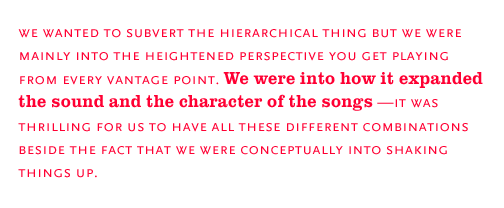
What musical projects have you been involved with since the end of UT?
Sally: I formed a band called Parachute soon afterwards, which was short-lived and only made it as far as a few gigs, as we eventually discovered as we progressed that we had different goals. I then formed a band called Quint, with a line-up of guitar and vocals, bass, drums, trumpet and violin. That lasted about five years, in which time we put out a single on vinyl (“Blueprint to a Blackout”/”Sawtooth”) and an album on CD (Time Wounds All Heals). Quint meant a great deal to me, but changes in the line-up eventually led to a band whose chemistry was askew and that wasn’t functioning properly, so it came to an end. At the moment, I’m singing with a jazz and blues band that gigs about once a month in Soho in London.
Jacqui: After Ut, I formed Dial with Robert Smith, both of us on guitar. Lou Ciccotelli was our drummer for 2 years and Dom Weeks (of Furious Pig) came in on bass and synth. In ‘93 Lou left and Rob started to play the drum machine as well as guitar.
Dial has released two CDs, Infraction and Distance Runner, and a third is to be released this fall on our label Cede.
Do you listen to your own music with a critical ear, or is it possible to lose yourself in it?
Jacqui: You always get lost in music to some extent —I can be swept away while having a critical ear. A bad movie can be engrossing. Film and music operate as hypnotics.
With my own music I know the flaws and sometimes this messes up the experience but it’s a mood thing —everything we’ve released has some dynamic that outweighs the problems.
Sally: I have to admit that I find it particularly difficult to listen to my own music without a critical ear. But sometimes I manage to shake off the critic and find myself surprisingly moved by music I’ve made in the past. We’re working on re-releasing Ut material, so I’ve been listening to a lot of Ut’s music lately. Some songs feel shockingly close to home and have even moved me to tears, while others feel strangely alien. It’s a great experience to hear things you’ve done in the past when you haven’t listened to them for awhile, as time provides a distance and objectivity that allows you to hear and discover things in the music that you may not have tuned into before. Other times, you recognize the same old problems you remembered having with the music at the time. But it can potentially refresh one’s perspective.
Is it disheartening to you that women in mainstream pop are still —by and large— airbrushed and cookie-cutter, not to mention fairly problematic as role models? It’s true that the males are too, but that’s hardly moving in the right direction as far as enlightened equality is concerned. Is there anything inspiring going on in mainstream pop right now?
Jacqui: The doll-like diva thing pollutes every part of the music scene, the mainstream just flaunts the essence more, everybody is complicit. Creative role models inspire you to create —it is irrelevant if they are male or female. Every woman can be a role model for other women no matter what she does. What matters is how she handles herself.
Sally: I agree that sometimes it seems as if women haven’t come very far. But there are some exceptions. There’s a lot more women picking up instruments and playing them focusing on the music rather than how they look or whether their gender is an issue.
The drummer in my band Quint (Stephen Gilchrist, aka Stuffy) has since formed a band called The Fuses in which there’s a girl guitarist named Jen Macro who is how I’d imagined girls to be in bands by the 21st century. She’s a fantastic guitar player, completely natural (dresses like she’s hanging out in her living room), yet has a great presence and exudes both toughness and vulnerability. You can just tell she’s up there thinking about the music and her singing and guitar playing and making it happen. There’s no other agenda. It’s pure substance rather than appearance. She’s definitely the kind of girl who should be a role model for other girls who want to be in bands. Every time I see her, I find her an inspiration.
There are others like her, just not enough. A lot of girls either vie for center of attention as the diva, so to speak, or take a meek decorative background role. It’s inspiring to see a band where it feels like the gender doesn’t matter.
TO BE CONTINUED

The songs that follow are all sung by Sally Young. | “Sham Shack” was originally self-released in 1984 as part of an eponymously-titled 12” on the band’s own label, Out. You can find it on the New York Noise Volume 2. | “Wailhouse” is from the band’s final release, Griller. Initially released in 1989 on Blast First, it will get a re-issue this August from Mute. | “Phoenix” is from the group’s first proper full-length, Conviction. Currently unavailable (try GEMM or Ebay in the vain hopes of scoring a copy), it will hopefully be re-issued soon.
More info on “New York Noise Volume 2” can be found here. To purchase, try Amazon, Rough Trade UK, or Insound.
For DIAL material, try Forced Exposure, Crucial Blast or Amanita Records (a French record label that also offers mail-order). You can also write to cede (at) optonline.net.
 Ut, “Sham Shack”
Ut, “Sham Shack”
 Ut, “Wailhouse”
Ut, “Wailhouse”
 Ut, “Phoenix”
Ut, “Phoenix”
![]() Flying Lizards, “Her Story” [vocals by Vivien Goldman; for more of her work visit this recent post from Postpunk Junk.]
Flying Lizards, “Her Story” [vocals by Vivien Goldman; for more of her work visit this recent post from Postpunk Junk.]![]() The Homosexuals, “In Search of the Perfect Baby”
The Homosexuals, “In Search of the Perfect Baby”
